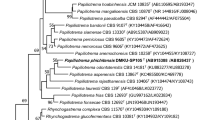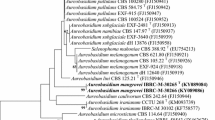Abstract
Two strains (AHD129-1T and AHD129-2) of a new anamorphic yeast species were isolated from Mejare cave soil samples of Abdanan, Ilam, Iran. Nucleotide divergence in the D1/D2 domain of the large subunit (LSU) rRNA, and internal transcribed spacer (ITS) genes suggest that the two strains can be assigned to the Trichomonascus/Blastobotrys clade. A maximum likelihood tree based on sequences of the D1/D2 domain revealed that the new species is closely related to the species Trichomonascus ciferrii, Candida allociferrii, and Candida mucifera. The new species could be distinguished from the closely related species by its ability to grow at 42 °C and the inability to assimilate d-arabinose and d-mannitol. The name B. persicus sp. nov. is proposed for the new anamorphic species. The type strain of B. persicus is AHD129-1T = IBRC-M30238T = CBS 14259T, and the Mycobank number is MB 819148.


Similar content being viewed by others
Abbreviations
- LSU:
-
Large subunit
- ITS:
-
Internal transcribed spacer
- SSU:
-
Small subunit
References
Barnett JA, Payne RW, Yarrow D (2000) Yeasts: characteristics and identification, 3rd edn. Cambridge University Press, Cambridge
Chelius MK, Beresford G, Horton H, Quirk M, Selby G, Simpson RT, Horrocks R, Moore JC (2009) Impacts of alterations of organic inputs on the bacterial community within the sediments of Wind Cave, South Dakota, USA. Int J Speleol 38:1–10
de Hoog GS, Rantio-Lehtimäki AH, Smith MT (1985) Blastobotrys, Sporothrix and Trichosporiella: generic delimitation, new species, and a Stephanoascus teleomorph. Antonie Van Leeuwenhoek 51:79–109
Fell JW, Statzell AC (1971) Sympodiomyces gen. n., a yeast-like organism from southern marine waters. Antonie Van Leeuwenhoek 37:359–367
Felsenstein J (1985) Confidence limits on phylogenies: an approach using the bootstrap. Evolution 39:783–791
Grishkan I, Nevo E, Wasser SP (2004) Micromycetes from the saline arubotaim cave: mount Sedom, the dead sea southwestern shore, Israel. J Arid Environ 57:431–443
Hsu MJ, Agoramoorthy G (2001) Occurrence and diversity of thermophilous soil microfungi in forest and cave ecosystems of Taiwan. Fungal Divers 7:27–33
Jackson HS (1947) Trichomonascus, a new genus among simple Ascomycetes. Mycologia 39:709–715
Jurado V, Fernandez-Cortes A, Cuezva S, Laiz L, Cañaveras JC, Sanchez-Moral S, Saiz-Jimenez C (2009) The fungal colonization of rock-art caves: experimental evidence. Naturwissenschaften 96:1027–1034
Kamyabi A, Nouri H, Moghimi H (2017) Synergistic effect of Sarocladium sp. and Cryptococcus sp. co-culture on crude oil biodegradation and biosurfactant production. Appl Biochem Biotechnol 182:324–334
Kimura M (1980) A simple method for estimating evolutionary rates of base substitutions through comparative studies of nucleotide sequences. J Mol Evol 16:111–120
Kurtzman CP (2007) Blastobotrys americana sp. nov., Blastobotrys illinoisensis sp. nov., Blastobotrys malaysiensis sp. nov., Blastobotrys muscicola sp. nov., Blastobotrys peoriensis sp. nov. and Blastobotrys raffinosifermentans sp. nov., novel anamorphic yeast species. Int J Syst Evol Microbiol 57:1154–1162
Kurtzman CP, Robnett CJ (1998) Identification and phylogeny of ascomycetous yeasts from analysis of nuclear large subunit (26S) ribosomal DNA partial sequences. Antonie Van Leeuwenhoek 73:331–371
Kurtzman CP, Robnett CJ (2007) Multigene phylogenetic analysis of the Trichomonascus, Wickerhamiella and Zygoascus yeast clades, and the proposal of Sugiyamaella gen. nov. and 14 new species combinations. FEM Yeast Res 7:141–151
Kurtzman CP, Fell JW, Boekhout T, Robert V (2011) Methods for isolation, phenotypic characterization and maintenance of yeasts. In: Kurtzman CP, Fell JW, Boekhout T (eds) The yeasts, a taxonomic study, 5th edn. Elsevier, Amsterdam, pp 97–107
Kuzmina LY, Galimzianova NF, Abdullin SR, Ryabova AS (2012) Microbiota of the Kinderlinskaya cave (South Urals, Russia). Microbiology 81:251–258
Lachance MA, Bowles JM, Mueller C, Starmer WT (2000) On the biogeography of yeasts in the Wickerhamiella clade and description of Wickerhamiella lipophila sp. nov., the teleomorph of Candida lipophila. Can J Microbiol 46:1145–1148
Lachance MA, Boekhout T, Scorzetti G, Fell JW, Kurtzman CP (2011) Candida berkhout. In: Kurtzman CP, Fell JW, Boekhout T (eds) The yeasts, a taxonomic study, 5th edn. Elsevier, Amsterdam, pp 987–1278
Moghimi H, Tabar RH, Hamedi J (2017) Assessing the biodegradation of polycyclic aromatic hydrocarbons and laccase production by new fungus Trematophoma sp. UTMC 5003. World J Microbiol Biotechnol 33:136
Mulec J, Zalar P, Hajna NZ, Rupnik M (2002) Screening for culturable microorganisms from cave environments (Slovenia). Acta Carsologica 31:177–187
Péter G, Dlauchy D, Tornai-Lehoczki J, Suzuki M, Kurtzman CP (2011) Spencermartinsiella europaea gen. nov., sp. nov., a new member of the family Trichomonascaceae. Int J Syst Evol Microbiol 61:993–1000
Pohl CH, Kriel W, Venter P, Van Heerden E, Albertyn J (2007) The diversity of culturable airborne fungi in an active South African gold mine. S Afr J Sci 103:277–278
Rutherford JM, Huang LM (1994) A study of fungi of remote sediments in West Virginia caves and a comparison with reported species in the literature. J Cave Karst Stud 56:38–45
Smith MT, de Hoog GS, Malloch D (2011) Trichomonascus. In: Kurtzman CP, Fell JW, Boekhout T (eds) The yeasts, a taxonomic study, 5th edn. Elsevier, Amsterdam, pp 875–881
Thompson JD, Gibson TJ, Plewniak F, Jeanmougin F, Higgins DG (1997) The CLUSTAL_X windows interface: flexible strategies for multiple sequence alignment aided by quality analysis tools. Nucleic Acid Res 24:4876–4882
Ueda-Nishimura K, Mikata K (2002) Species distinction of the ascomycetous heterothallic yeast-like fungus Stephanoascus ciferrii complex: description of Candida allociferrii sp. nov. and reinstatement of Candida mucifera Kocková-Kratochvílová et Sláviková. Int J Syst Evol Microbiol 52:463–471
Urzi C, De Leo F, Bruno L, Albertano P (2010) Microbial diversity in Paleolithic caves: a study case on the phototrophic biofilms of the cave of bats (Zuheros, Spain). Microb Ecol 60:116–129
van der Walt JP, Th Smith M, Yamada Y (1990) Arxula gen. nov. (Candidaceae), a new anamorphic, arthroconidial yeast genus. Antonie Van Leeuwenhoek 57:59–61
Vanderwolf KJ, Malloch D, McAlpine DF, Forbes GJ (2013) A world review of fungi, yeasts, and slime molds in caves. Int J Speleol 42:9
Vaughan-Martini A, Angelini P, Zacchi L (2000) The influence of human and animal visitation on the yeast ecology of three Italian caverns. Ann Microbiol 50:133–140
von Klopotek A (1967) Blastobotrys nivea gen. nov., sp. nov. Arch Microbiol 58:92–96
White TJ, Bruns T, Lee SJWT, Taylor JW (1990) Amplification and direct sequencing of fungal ribosomal RNA genes for phylogenetics. PCR Protoc 18:315–322
Yoder JA, Benoit JB, Christensen BS, Croxall TJ, Hobbs HH III (2009) Entomopathogenic fungi carried by the cave orb weaver spider, Meta ovalis (Araneae, Tetragnathidae), with implications for mycoflora transfer to cave crickets. J Cave Karst Stud 71:116–120
Acknowledgements
The authors thank the University of Tehran for partial financial support for accomplishing the present research under Grant No. 321265/04/6.
Author information
Authors and Affiliations
Corresponding author
Ethics declarations
Conflict of interest
The authors declare no conflicts of interest.
Rights and permissions
About this article
Cite this article
Nouri, H., Moghimi, H., Geranpayeh Vaghei, M. et al. Blastobotrys persicus sp. nov., an ascomycetous yeast species isolated from cave soil. Antonie van Leeuwenhoek 111, 517–524 (2018). https://doi.org/10.1007/s10482-017-0972-x
Received:
Accepted:
Published:
Issue Date:
DOI: https://doi.org/10.1007/s10482-017-0972-x




